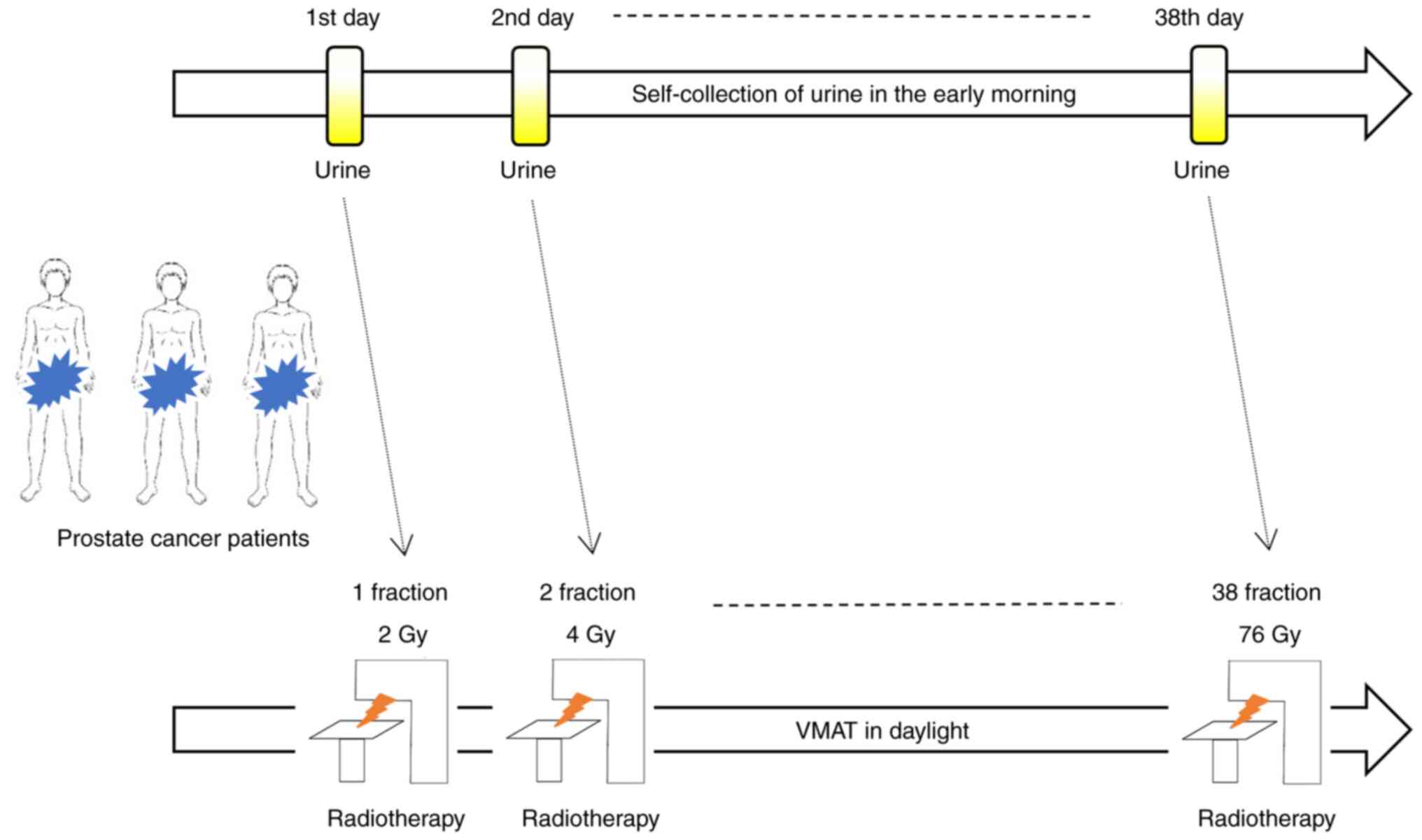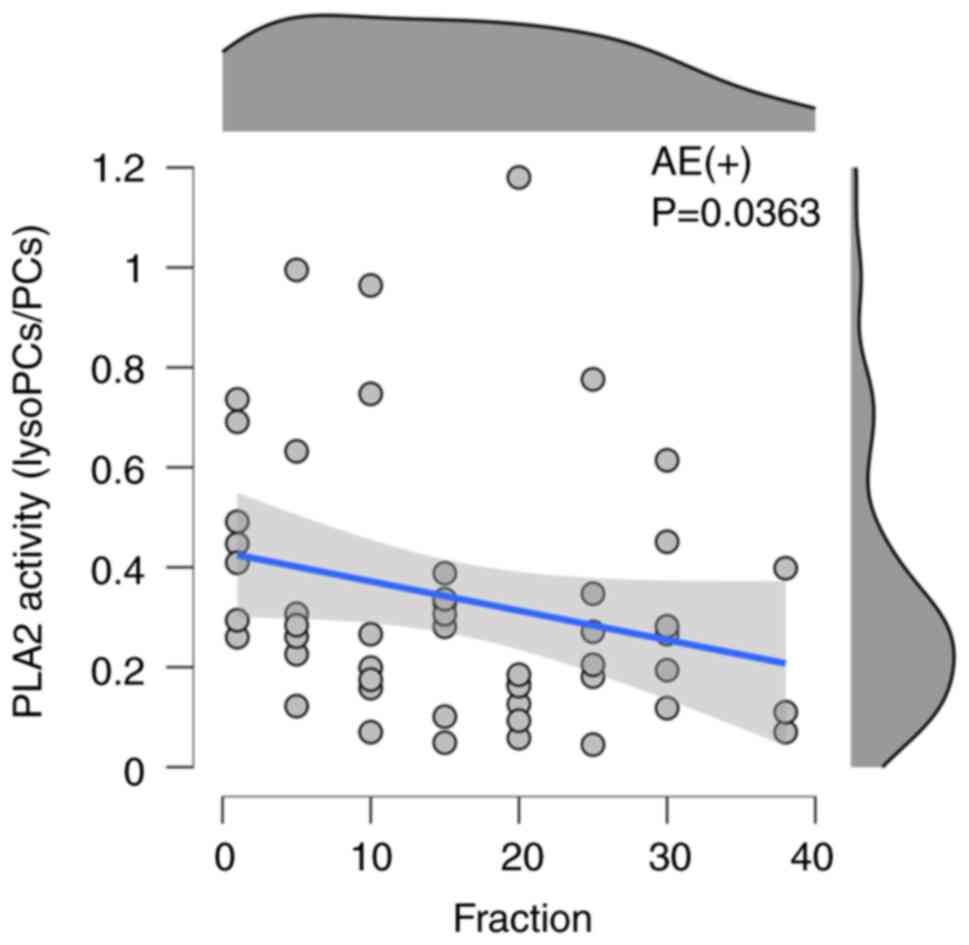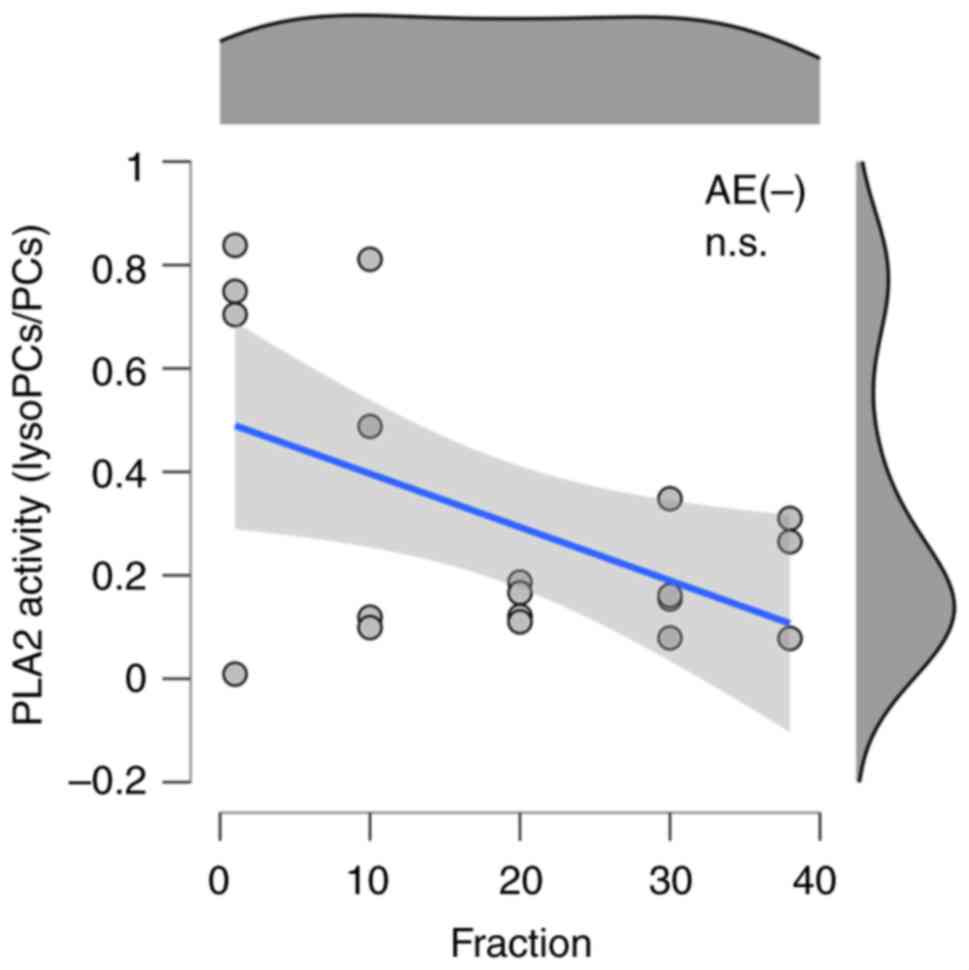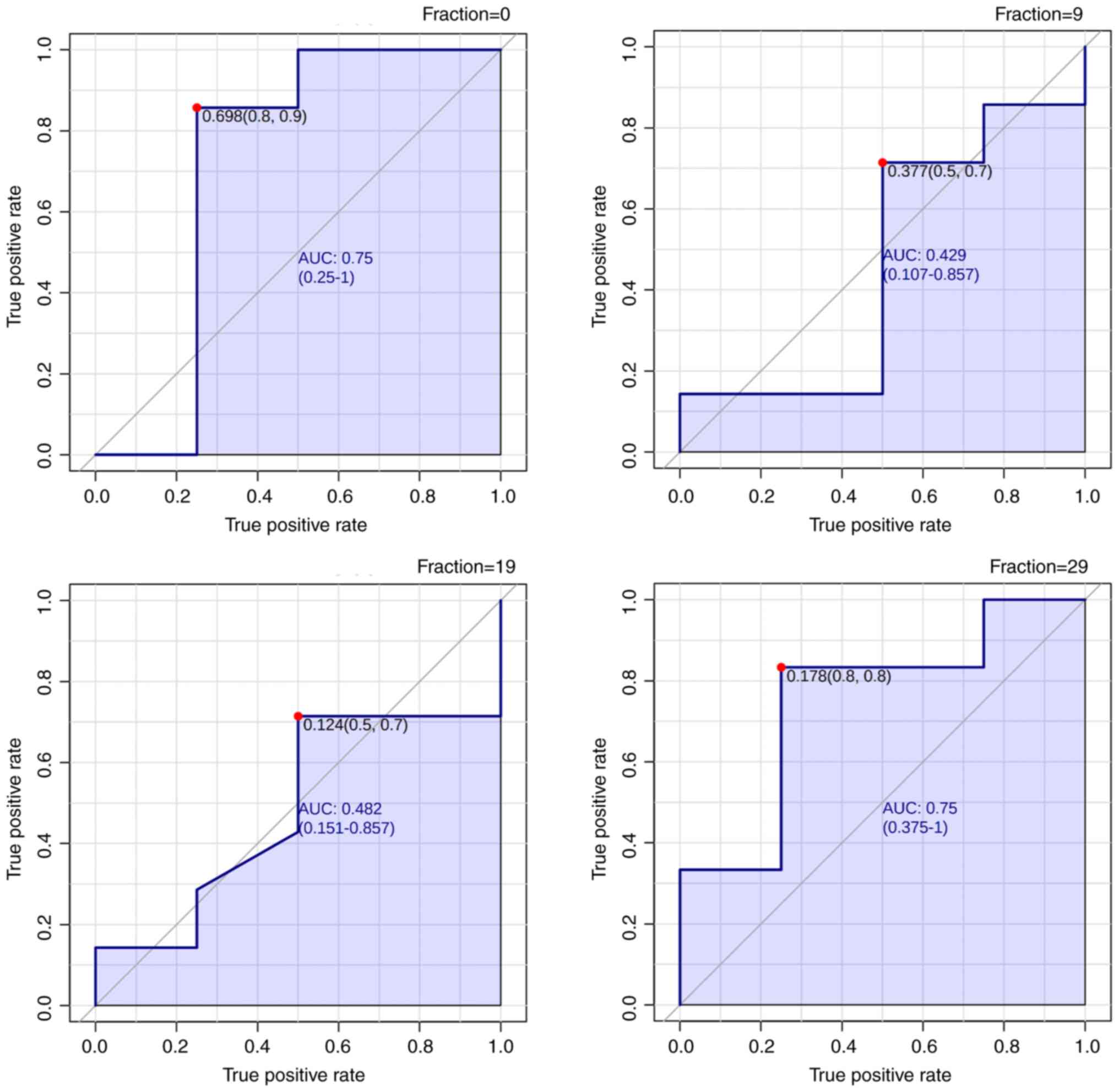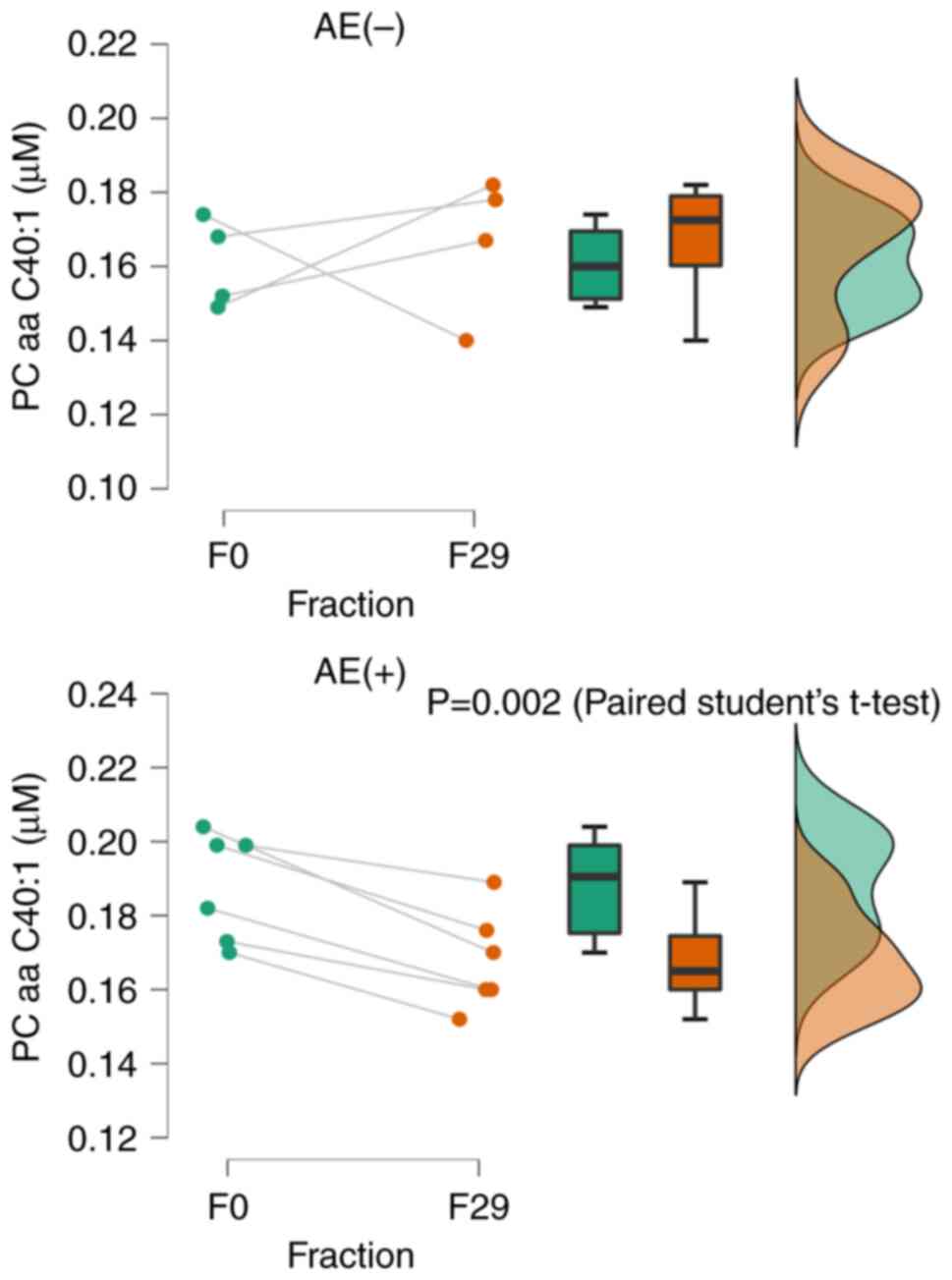Exploring predictive molecules of acute adverse events in response to volumetric‑modulated arc therapy for prostate cancer using urinary metabolites
- Authors:
- Published online on: July 9, 2024 https://doi.org/10.3892/mco.2024.2760
- Article Number: 62
-
Copyright: © Obara et al. This is an open access article distributed under the terms of Creative Commons Attribution License.
Abstract
Introduction
In Japan, the number of patients who have received radiotherapy for cancer has increased since 1995. With the rapidly increasing number of patients with prostate cancer in their 50s and older, as well as an aging society, radiotherapy is expected to be one of the treatment methods used. There were 851 radiotherapy facilities in Japan (1), with intensity-modulated radiotherapy (IMRT), a type of high-precision radiotherapy, being the most commonly used for prostate cancer cases, with over 320 facilities (1). In 2020, 423 facilities were equipped to provide IMRT (2), making it easier for patients to receive treatment. Conversely, for prostate cancer, adverse events (AE) are a significant issue in external beam radiotherapy. Acute AEs include diarrhea, proctitis, cystitis, fatigue, and mild skin irritation, primarily in the gluteal fold (3). Furthermore, the most recent Japanese radiotherapeutic guideline (JASTRO Guidelines 2020) identified dysentery, dermatitis around the anus, rectal bleeding, and frequent urination as AEs (4). Genitourinary toxicity, such as bladder spasms, cystitis, genitourinary fistula, urinary incontinence, genitourinary leak, genitourinary obstruction, genitourinary perforation, prolapse of stoma, renal failure, stricture/stenosis, urinary electrolyte wasting, urinary frequency/urgency, and urinary retention (5), is particularly associated with a decrease in quality of life after treatment initiation. These diagnoses are primarily made by interview and direct observation of the patient. Therefore, no standard biomarkers are known for a priori prediction of them.
A rough treatment plan is developed once the cancer type and pathology are identified within the current radiotherapy strategy. The patient's condition during treatment is monitored through medical examination, blood and urine sampling, and diagnostic imaging; however, little radiobiological information is considered, making it difficult to predict AEs. Thus, there is no definitive method for confirming the response of target tissue cells or organs at risk in real time (6), and it is proposed to incorporate this biological response into radiotherapy strategies.
A well-established theory in which 4R radiobiological concepts are considered is fractionated radiotherapy. Out of these concepts, only ‘repair’ is considered in the linear-quadratic model (7,8). In clinical practice, assessing the remaining reoxygenation, redistribution, and repopulation (3Rs) in real time has proven difficult. Recent technological advances in molecular biology, as well as increased statistical analysis speed, have enabled more detailed analysis of cancer cells. Furthermore, new theories have emerged that challenge conventional theories of radiation biology. Particularly, cancer cell metabolism remains largely unknown because of the diversity of their characteristics.
Metabolome analysis, which has gained popularity in recent years, can detect metabolite changes using mass spectrometry with high qualitative and quantitative accuracy (9). In this study, metabolomics was performed on urine samples from patients with localized prostate cancer to identify biomarkers predictive of acute AEs.
The European Association of Urology now recommends dose-escalated IMRT or volumetric-modulated arc therapy (VMAT) as standard therapies for prostate carcinoma because of the lower toxicity compared to 3D-conformal radiotherapy (3D-CRT) (10). VMAT may be the first option (11) and is widely accepted as the gold standard for prostate radiotherapy (12). With the use of modern RT (IMRT, VMAT), greater precision was achieved when compared to conventional RT (13). Various studies have established IMRT as the standard of care for external beam RT for prostate cancer, with a lower rate of acute and late RT-induced toxicities compared to 3D-CRT (14). To optimize planning for VMAT, which has fewer acute and late complications, the AUA/ASTRO guideline 2022 recommended the use of highly conformal radiotherapy such as IMRT, VMAT, and stereotactic body radiotherapy, in conjunction with published target and normal tissue dose objectives (15).
The high radiation dose rate causes DNA damage in cancer cells as a direct or indirect reaction mediated by ROS. The most serious damage is caused by DNA single-strand breaks and double-strand breaks. Several AEs are caused by chronic oxidative stress, which impairs the nuclear function of DNA repair mechanisms (16). However, there are different types of AEs based on symptoms, frequency, and severity.
Identifying and predicting metabolites that respond to acute AEs in external beam radiotherapy would help to maintain radiotherapy safety and quality of life, as well as improve treatment selection (i.e., optimization). This study sought to identify a predictive biomarker from urinary metabolites for AEs during VMAT in localized prostate cancer and to optimize this radiotherapy in preparation for an increase in target patients.
Materials and methods
Study population
The current study included 11 patients with localized prostate cancer who received VMAT at Hirosaki University Hospital between June 2021 and March 2022 were enrolled (Fig. 1). All of the patients were Asians from across eastern Japan. The key characteristics examined included age, T stage, Gleason score, prostate-specific antigen (PSA), National Comprehensive Cancer Network (NCCN) risk classification, and fraction with acute AEs. The acute AEs highlighted in this study were classified using the Common Terminology Criteria for Adverse Events Version 5.0 from the U.S. Department of Health and Human Services (https://ctep.cancer.gov/protocolDevelopment/electronic_applications/ctc.htm#ctc_50).
Patient urination
The participants were patients with localized prostate cancer who underwent VMAT (76 Gy/38 fractions) at Hirosaki University Hospital between June 2021 and March 2022. Urine was self-collected using Uro Catch II (ATLETA Corp., Ltd., Osaka, Japan) early in the morning at rest and via midstream catch (10 ml). Self-urination samples were collected daily from the first to the last day of irradiation (Fig. 1). Urine samples were collected and stored in a freezer (MY BIO VT-208HC, Nihon freezer Corp., Ltd., Tokyo, Japan) at -80˚C, to ensure metabolite stability until mass spectrometry analysis. Acute AEs such as urinary frequency during the irradiation period were documented during the patient's medical interview.
Metabolomics
Urine samples were thawed to room temperature. A total of 630 metabolites from 14 small molecules and 12 different lipid classes were analyzed using the MxP® Quant 500 kit (Biocrates Life Sciences AG, Innsbruck, Austria) according to the manufacturer's instructions. Approximately 10 µl of urine was pipetted on a 96-well plate with internal standards and dried under a nitrogen stream using a positive-pressure manifold (Biotage AB, Uppsala, Sweden). Then, 50 µl of 5% phenyl isothiocyanate solution was added to each well to derivatize amino acids and biogenic amines. After 1 h of incubation at room temperature, the plate was dried again. To extract metabolites, 300 µl of 5-mM ammonium acetate in methanol was pipetted into each filter and incubated for 30 min. The extract was eluted into a new 96-well plate via a positive-pressure manifold. To conduct further LC-MS/MS analyses, the 150-µl extract was diluted with an equal volume of water. For FIA-MS/MS analyses, a 10-µl extract was diluted with 490-µl FIA solvent (Biocrates). LC-MS/MS and FIA-MS/MS measurements were performed following dilution. For chromatographic separation, an ExionLC AD (AB SCIEX, Framingham, Massachusetts, USA) system was connected to a SCIEX QTRAP 6500+ mass spectrometry system in electrospray ionization mode. Data were generated using the Analyst (AB SCIEX) software suite and transferred to the MetIDQ software (using the Recipe Urine QC), where they were further processed and analyzed. All metabolites were identified using isotopically labeled internal standards and multiple reaction monitoring through optimized MS conditions provided by Biocrates. For quantification, a seven-point calibration curve or one-point calibration was used depending on the metabolite class. Urine samples were processed with no prior preparation. Furthermore, in each well (except for the blank), an internal standard (creatinine) was added before urine was pipetted onto the plate. Metabolite concentrations were adjusted for creatinine content. Biologically and clinically relevant 293 metabolic indices were determined using the MetaboINDICATOR tool (Biocrates). Each metabolite was given absolute quantitative values. The collected metabolome data was registered to the integrated metabolome data repository (MetaboBank; MTBKS242 and MTBKS243),
Statistical analysis
Using R (Ver. 4.2.0), statistical analysis was conducted, as well as correlation analysis (Spearman's rank correlation) was performed between these metabolic indices and acute AEs or metabolic indices and fraction (physical quantity). Receiver operating characteristic (ROC) curves were produced using MetaboAnalyst (17) on metabolic indices that showed a significant correlation with the number of irradiations. The paired samples Student's t-test was run on fractions ranging from 0 to 29 to look for metabolites associated with various metabolic indicators with and without AEs. P<0.05 was considered to indicate a statistically significant difference.
Results
Patient characteristics
We identified 11 patients who had localized prostate cancer and underwent VMAT. Four patients (median age, 69 years) had no confirmed AEs, while the remaining seven patients (71 years) experienced genitourinary toxicity (GU, Grade 1). The clinical characteristics of the study population are shown in Table I. With a median PSA of 7.23 ng/ml, T2b-T3b of 72.7%, and a median total Gleason score of 7 (6-9), NCCN high-risk constituted 54.5% (n=6) of the study population.
Indicator of lipid metabolism
It has been reported that the phospholipase A2 activity (PLA2 activity) in healthy adults is approximately 1.21(18). This was higher values than the fraction zero (F=0) of AEs (0.48±0.18) and F=0 of non-AEs (0.58±0.38) in the current data. In seven patients with acute AE(+), Spearman's rank correlation revealed a significant correlation between the fraction and the PLA2 activity index (rs=-0.297, P<0.05) in Fig. 2 and Table II. There was no significant correlation found with the absence of AEs (Fig. 3 and Table II). Because PLA2 activity is represented in the MetaboINDICATOR as lysoPC a Cxx:x/PC ax Cxx:x, we chose to focus on lysophosphatidylcholine (lysoPC) and phosphatidylcholine (PC) as metabolites linked to radiation-induced AEs.
ROC analysis of metabolic indicators
The ROC curves for the PLA2 activity index in each fraction are shown in Fig. 4 and Table III. The cutoff value of the PLA2 Activity index was 0.178 in 29 fractions, resulting in an area under the curve (AUC) of 0.75. Fraction 0 also had a high AUC of 0.75; however, fractions 9 and 19 did not have an AUC greater than 0.5, indicating a random prediction. Thus, the PLA2 activity index demonstrated high specificity and sensitivity as a biomarker in fractions 0 and 29 for predicting the occurrence of AEs.
Lipid evaluation classification in metabolomics
PLA2 activity was found to be correlated with fractions through correlation analysis. The use of this index as a biomarker necessitates measuring the entire series of lysoPCs and PCs. Thus, we explored surrogate markers for PLA2 activity by performing paired samples Student's t-test for metabolites associated with the PLA2 activity index. Phosphatidylcholine with diacyl residue sum C40:1 (PC aa C40:1) was significantly reduced in the presence of AEs (P<0.01). However, there was no significant difference without AEs (Fig. 5). This suggests that a reduction in PC aa C40:1 at 29 fractions is indicative of an AE. In the post-treatment serum data, PSA could be used as a known indicator of tumor activity. PSA levels in the AE(+) population decreased after radiotherapy (Table IV).
Discussion
This study aimed to explore metabolites that predict acute AEs in patients with localized prostate cancer who underwent VMAT with urine. Patient analysis of acute AE was conducted at every outpatient visit during the VMAT course for approximately 2 months. While numerous urinary toxicity biomarkers have been reported, we discovered a specific parameter for the detection of AE: the PLA2 activity index, which reacts during the phase of 30 fractions (60 Gy as cumulative dose) in the VMAT course (6 and 7 weeks from initial fraction) (Figs. 2, 3, and 5). In this study, radiotherapy was performed according to JASTRO Guidelines (4), and urine samples were collected at regular intervals. This type of analysis has not been reported, but post-treatment serum data (PSA) can be used as a known indicator of tumor activity. PSA levels decreased after radiotherapy, indicating an antitumor effect. It is critical to monitor PSA concentrations in peripheral blood, but invasive blood sampling is difficult to perform frequently. Therefore, urine has the advantage of being simple to collect and useful for tracking markers over time during treatment. PLA2 activity is calculated using the lysoPCs to PCs ratio, and Zhai et al found that PLA2 activity upregulation is associated with both inflammatory and noninflammatory types of osteoarthritis (19). According to reports dating back more than 30 years, extracellular phospholipase A2 expression has been linked to inflammation-related diseases (20). In this study, we discovered for the first time a negative correlation between Grade 1 AE by VMAT and PLA2 activity. LysoPC and PC are produced by various metabolic pathways and degraded by enzymes. AE can reflect these metabolites directly or indirectly. Wegener et al reported the highest acute GU toxicity with grades 1 and 2 in weeks 7 and 8 of radiotherapy (21). Spratt et al found that the GI and GU scores in grades 2 and 3 gradually increased during treatment, plateauing after 5 weeks and peaking at 7 weeks (22). According to the reports of these radiotherapy-related AEs, we believe that the significant decrease in the maximum GU score and PLA2 activity in fraction 30 is accurately reflected. The AUC calculated from the ROC generated by the current predictors is a measure of their accuracy. According to the AUC values, test accuracy can be classified as perfect (AUC=1), highly accurate (AUC=0.9-1), moderately accurate (AUC=0.7-0.9), less accurate (AUC=0.5-0.7), and noninformative (AUC=0.5) (23). According to this AUC guideline, the predictors developed in the current study for investigating predictive molecules of AE events were moderately accurate (Fig. 4). Alicikus et al found that when using IMRT to localize prostate cancer, the presence of acute Grade >2 GU toxicity predicted the development of late Grade >2 GU toxicity using a multivariate analysis (24). Zelefsky et al found that the presence of acute gastrointestinal (GI) and GU symptoms during treatment conferred a 5-fold and 3-fold increase in the risk of late GI and GU toxicities, respectively, in 1,571 prostate cancer patients who had a long follow-up after receiving three-dimensional, conformal radiotherapy or IMRT (25). In contrast, our findings for GU toxicity clearly revealed that manifesting GU symptoms prior to radiotherapy initiation is a strong predictor of acute GU toxicity, as 94% of patients with a Grade 2 before radiotherapy also scored a Grade 2 as the maximum acute GU score (26).
Both the preRT baseline IPSS score of >15 (P<0.001) and acute GU toxicity (P<0.001) predicted late GU toxicity. The RTOG study 94-06 showed an excellent toxicity profile with a dose escalation of up to 79.2 Gy, with the use of 3D-CRT, with ≤3% of patients experiencing a Grade 3 GI or GU acute toxicity, and 85% of patients experiencing no late toxicity or Grade 1 toxicity (22). According to the above reports, the discovery of a biomarker that predicts Grade 1 AEs based on PLA2 activity is extremely important because it allows us to prepare for severe AEs of Grade 2 or higher. This marker can be used to reconsider treatment regimens to prevent AEs when there is a negative correlation in the number of fractions vs. PLA2 activity with continued urine collection. According to a recent paper, hyperbaric oxygen therapy can be used to prevent AEs during radiotherapy (27). Combining these can be considered a new measure against AEs. The limitation of this study is the small sample size used to analyze the prediction of acute AE in other grades (more than 2) (28,29), and lack of healthy group as control. However, it is encouraging that despite the small sample size, the predictor of treatment delay was moderately accurate. Future studies with larger sample sizes may enable the identification of predictive molecules for acute AEs. Detection of PLA2 activity is associated with inflammatory diseases. Kartikasari et al explained that the tumor microenvironment is an environment of chronic inflammation (30). Interestingly, Zhao et al reported that plasma LysoPC [20:2] and LysoPC [20:3] decrease depending on radiation exposure doses and suggested that it is involved apoptosis (31). It is suggested that there are two regulation pathways by lysoPCs production, one is inflammatory pathway, the other is radiation induces apoptotic pathway. These may be involved in the increase or decrease in LysoPCs and AE, which determines PLA2 activity levels, but the details remain unknown. There is currently no information the relationship between these pathways, metabolites and impact of genitourinary toxicity (Grade 1). Furthermore, the analysis of the biological function, these pathways associated with the identified metabolites, and their relationship to genitourinary toxicity will be clarified by basic experiments using a cell line model.
In conclusion, this study demonstrated the significance of genitourinary metabolite biomarkers in predicting radiotherapy toxicity using urine metabolomics. In patients undergoing VMAT for localized prostate cancer, the surrogate marker PC aa C40:1 for PLA2 activity was found to predict genitourinary (Grade 1) acute AEs at approximately 30 fractions. Larger sample sizes are expected to improve accuracy even more in future validation studies.
Acknowledgements
The authors are grateful to Ms. Miyu Miyazaki (Center for Scientific Equipment Management, Hirosaki University Graduate School of Medicine) for her help with the LC-MS/MS analysis.
Funding
Funding: This work was supported by KAKENHI, Grant-in-Aid for Early-Career Scientists (grant no. 20K16685, Hideki Obara), Grants-in-Aid for Scientific Research (B) (grant no. 21H02861, Satoru Monzen) and Grant-in-Aid for Challenging Research (Exploratory) (grant no. 19K22731, Satoru Monzen). The funders had no role in the study design, data collection and analysis, decision to publish, or manuscript preparation.
Availability of data and materials
The metabolomics data generated in the present study may be found in the MetaboBank under accession numbers MTBKS242 and MTBKS243 or at the following URLs: https://mb2.ddbj.nig.ac.jp/study/MTBKS242.html and https://mb2.ddbj.nig.ac.jp/study/MTBKS243.html.
Authors' contributions
HO, SaM, and YT designed the study, prepared the manuscript draft and substantively participated in the manuscript revision. ShM, HY, NK, MS, FK, MN, YH and MA analyzed both the patient and biological data. SaM and MA supervised the study, critically reviewed the manuscript, and provided final approval for the version to be submitted and published. All authors have read and approved the final version of the manuscript. HO, YT and SaM confirmed the authenticity of all the raw data.
Ethics approval and consent to participate
This study was approved by the Medical Ethics Committee of Hirosaki University Graduate School of Medicine (Hirosaki, Japan; approval no. 2020-075) to ensure the welfare and privacy of the donors. Following a detailed verbal explanation regarding the content of this study, written informed consent was obtained.
Patient consent for publication
All patients and their families provided both written and oral informed consent for publication.
Competing interests
The authors declare that they have no competing interests.
References
|
Numasaki H, Nakada Y, Ohba H and Nakamura K: Japanese Structure Survey of Radiation Oncology in 2019 (First Report): Japanese Society for Radiation Oncology; JASTRO Database Committee, 2022. https://www.jastro.or.jp/medicalpersonnel/data_center/JASTRO_NSS_2019-01.pdf, Accessed July 7, 2024 (In Japanese). | |
|
Ministry of Health, Labour and Welfare: Summary of Static/Dynamic Surveys of Medical Institutions and Hospital Report in 2020. https://www.mhlw.go.jp/english/database/db-hss/mih_report_2020.html. Accessed February 28, 2024 (In Japanese). | |
|
Iwamoto RR and Maher KE: Radiation therapy for prostate cancer. Semin Oncol Nurs. 17:90–100. 2001.PubMed/NCBI View Article : Google Scholar | |
|
Japanese Society for Radiation Oncology: JASTRO Guidelines 2020 for Radiotherapy Treatment Planning. 5th edition. Kanehara & Co. Ltd., 2020 (In Japanese). | |
|
David RV, Kahokehr AA, Lee J, Watson DI, Leung J and O'Callaghan ME: Incidence of genitourinary complications following radiation therapy for localized prostate cancer. World J Urol. 40:2411–2422. 2022.PubMed/NCBI View Article : Google Scholar | |
|
Monzen S, Tatsuya Ueno, Mitsuru Chiba and Yasushi Mariya: Exploratory study of biomarkers for radiation exposure adverse events. Nihon Hoshasen Gijutsu Gakkai Zasshi. 75:480–85. 2019.(In Japanese). | |
|
Franken NA, Oei AL, Kok HP, Rodermond HM, Sminia P, Crezee J, Stalpers LJ and Barendsen GW: Cell survival and radiosensitisation: Modulation of the linear and quadratic parameters of the LQ model (Review). Int J Oncol. 42:1501–1515. 2013.PubMed/NCBI View Article : Google Scholar | |
|
Annede P, Cosset JM, Van Limbergen E, Deutsch E, Haie-Meder C and Chargari C: Radiobiology: Foundation and new insights in modeling brachytherapy effects. Semin Radiat Oncol. 30:4–15. 2020.PubMed/NCBI View Article : Google Scholar | |
|
Meng W, Pan H, Sha Y, Zhai X, Xing A, Lingampelly SS, Sripathi SR, Wang Y and Li K: Metabolic connectome and its role in the prediction, diagnosis, and treatment of complex diseases. Metabolites. 14(93)2024.PubMed/NCBI View Article : Google Scholar | |
|
Mottet N, Bellmunt J, Bolla M, Briers E, Cumberbatch MG, De Santis M, Fossati N, Gross T, Henry AM, Joniau S, et al: EAU-ESTRO-SIOG guidelines on prostate cancer. Part 1: Screening, diagnosis, and local treatment with curative intent. Eur Urol. 71:618–629. 2017.PubMed/NCBI View Article : Google Scholar | |
|
Tøndel H, Lund JÅ, Lydersen S, Wanderås AD, Aksnessæther B, Jensen CA, Kaasa S and Solberg A: Radiotherapy for prostate cancer-does daily image guidance with tighter margins improve patient reported outcomes compared to weekly orthogonal verified irradiation? Results from a randomized controlled trial. Radiother Oncol. 126:229–235. 2018.PubMed/NCBI View Article : Google Scholar | |
|
Hunte SO, Clark CH, Zyuzikov N and Nisbet A: Volumetric modulated arc therapy (VMAT): A review of clinical outcomes-what is the clinical evidence for the most effective implementation? Br J Radiol. 95(20201289)2022.PubMed/NCBI View Article : Google Scholar | |
|
Halperin EC, Wazer DE, Perez CA and Brady LW: Perez and Brady's principles and practice of radiation oncology. 7th edition. Wolters Kluwer, PA, 2018. | |
|
Ghanem AI, Elsaid AA, Elshaikh MA and Khedr GA: Volumetric-modulated arc radiotherapy with daily image-guidance carries better toxicity profile for higher risk prostate cancer. Asian Pac J Cancer Prev. 22:61–68. 2021.PubMed/NCBI View Article : Google Scholar | |
|
Eastham JA, Auffenberg GB, Barocas DA, Chou R, Crispino T, Davis JW, Eggener S, Horwitz EM, Kane CJ, Kirkby E, et al: Clinically localized prostate cancer: AUA/ASTRO guideline. Part Ⅲ: Principles of radiation and future directions. J Urol. 208:26–33. 2022.PubMed/NCBI View Article : Google Scholar | |
|
Hubenak JR, Zhang Q, Branch CD and Kronowitz SJ: Mechanisms of injury to normal tissue after radiotherapy: A review. Plast Reconstr Surg. 133:49e–56e. 2014.PubMed/NCBI View Article : Google Scholar | |
|
Pang Z, Chong J, Zhou G, de Lima Morais DA, Chang L, Barrette M, Gauthier C, Jacques PÉ, Li S and Xia J: MetaboAnalyst 5.0: Narrowing the gap between raw spectra and functional insights. Nucleic Acids Res. 49(W1):W388–W396. 2021.PubMed/NCBI View Article : Google Scholar | |
|
Erben V, Poschet G, Schrotz-King P and Brenner H: Comparing metabolomics profiles in various types of liquid biopsies among screening participants with and without advanced colorectal neoplasms. Diagnostics (Basel). 11(561)2021.PubMed/NCBI View Article : Google Scholar | |
|
Zhai G, Pelletier JP, Liu M, Aitken D, Randell E, Rahman P, Jones G and Martel-Pelletier J: Activation of the phosphatidylcholine to lysophosphatidylcholine pathway is associated with osteoarthritis knee cartilage volume loss over time. Sci Rep. 9(9648)2019.PubMed/NCBI View Article : Google Scholar | |
|
Vadas P, Browning J, Edelson J and Pruzanski W: Extracellular phospholipase A2 expression and inflammation: The relationship with associated disease states. J Lipid Mediat. 8:1–30. 1993.PubMed/NCBI | |
|
Wegener D, Berger B, Outtagarts Z, Zips D, Paulsen F, Bleif M, Thorwarth D, Alber M, Dohm O and Müller AC: Prospective evaluation of probabilistic dose-escalated IMRT in prostate cancer. Radiol Oncol. 55:88–96. 2020.PubMed/NCBI View Article : Google Scholar | |
|
Spratt DE, Pei X, Yamada J, Kollmeier MA, Cox B and Zelefsky MJ: Long-term survival and toxicity in patients treated with high-dose intensity modulated radiation therapy for localized prostate cancer. Int J Radiat Oncol Biol Phys. 85:686–692. 2013.PubMed/NCBI View Article : Google Scholar | |
|
Greiner M, Pfeiffer D and Smith RD: Principles and practical application of the receiver-operating characteristic analysis for diagnostic tests. Prev Vet Med. 45:23–41. 2000.PubMed/NCBI View Article : Google Scholar | |
|
Alicikus ZA, Yamada Y, Zhang Z, Pei X, Hunt M, Kollmeier M, Cox B and Zelefsky MJ: Ten-year outcomes of high-dose, intensity-modulated radiotherapy for localized prostate cancer. Cancer. 117:1429–1437. 2011.PubMed/NCBI View Article : Google Scholar | |
|
Zelefsky MJ, Levin EJ, Hunt M, Yamada Y, Shippy AM, Jackson A and Amols HI: Incidence of late rectal and urinary toxicities after 3-dimensional conformal radiotherapy and intensity-modulated radiotherapy for localized prostate cancer. Int J Radiat Oncol Biol Phys. 70:1124–1129. 2008.PubMed/NCBI View Article : Google Scholar | |
|
Peeters ST, Heemsbergen WD, Van Putten WL, Slot A, Tabak H, Mens JW, Lebesque JV and Koper PC: Acute and late complications after radiotherapy for prostate cancer: Results of a multicenter randomized trial comparing 68 Gy to 78 Gy. Int J Radiat Oncol Biol Phys. 61:1019–1034. 2005.PubMed/NCBI View Article : Google Scholar | |
|
Oscarsson N, Müller B, Rosén A, Lodding P, Mölne J, Giglio D, Hjelle KM, Vaagbø G, Hyldegaard O, Vangedal M, et al: Radiation-induced cystitis treated with hyperbaric oxygen therapy (RICH-ART): A randomised, controlled, phase 2-3 trial. Lancet Oncol. 20:1602–1614. 2019.PubMed/NCBI View Article : Google Scholar | |
|
Dykstra MA, Switzer N, Eisner R, Tso V, Foshaug R, Ismond K, Fedorak R and Wang H: Urine metabolomics as a predictor of patient tolerance and response to adjuvant chemotherapy in colorectal cancer. Mol Clin Oncol. 7:767–770. 2017.PubMed/NCBI View Article : Google Scholar | |
|
Li X, Nakayama K, Goto T, kimura H, Akamatsu S, Hayashi Y, Fujita K, Kobayashi T, Shimizu K, Nonomura N, et al: High level of phosphatidylcholines/lysophosphatidylcholine ratio in urine is associated with prostate cancer. Cancer Sci. 112:4292–4302. 2021.PubMed/NCBI View Article : Google Scholar | |
|
Kartikasari AER, Huertas CS, Mitchell A and Plebanski M: Tumor-Induced inflammatory cytokines and the emerging diagnostic devices for cancer detection and prognosis. Front Oncol. 11(692142)2021.PubMed/NCBI View Article : Google Scholar | |
|
Zhao H, Xi C, Tian M, Lu X, Cai TJ, Li S, Tian XL, Gao L, Liu HX, Liu KH and Liu QJ: Identification of potential radiation responsive metabolic biomarkers in plasma of rats exposed to different doses of cobalt-60 gamma rays. Dose Response. 18(1559325820979570)2020.PubMed/NCBI View Article : Google Scholar |



